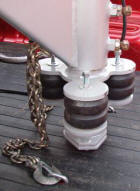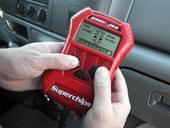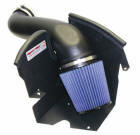|
SUVís and Trailers SUV's aren't my first choice as a tow vehicle, but I do understand the economics. Not everyone can afford a truck and a car. SUVís are becoming more popular each year. Get the biggest and longest is the short answer. The full-size SUVís have similar frames to trucks and a lot of them are boxed frames instead of C-frame, so they are strong. But you've got to get as much wheelbase as you can find. So to pull a trailer similar to a Ĺ ton truck, (GM, 1500, Dodge 1500, Ford F150, Toyota Tundra,) you need a SUV with a similar weight to a Ĺ ton truck. This would include Dodge Durango, Ford Expedition, Chevy Tahoe, GMC Yukon, Toyota Sequoia and others. These SUVís have a ďBody on FrameĒ construction like trucks. Always look at the vehicles trailer towing limits from the manufacture. Most factory brochures and manufacture web sites will give you the brake down of weight limits and hitch weight limits according to engine size, transmission, and rear axle ratio.For the highest trailer capacity, usually a weight distribution hitch is required with a receiver hitch, at least class 3 or higher. This is different from a weight carrying hitch, which is just a drawbar inserted into the receiver hitch. The weight-distributing hitch attaches to the trailer tongue with adjustments usually with chain links to transfer weight forward to the SUV. Yes I have pictures of these hitches, at http://www.mrtruck.net/trailers.htm In cases where the weight distributing hitch adjustment doesnít take all the sway away when pulling the trailer, a sway bar can be added to the weight-distributing hitch. All this will help you pull level, with weight on all of the axles of the SUV and trailer and less swaying from the bumper pull trailer.All of the SUVís listed above have rear coil springs with the exception of the Dodge Durango which has rear leaf springs. Rear coil springs are designed to give you a better ride, but this also gives you more rear movement. You donít want extra movement when pulling a trailer. So itís even more important to have a weight-distributing hitch on SUVís with rear coil springs and especially SUVís with independent rear axles. Independent rear axles are similar to front axle of a front wheel drive car. Each side can move independently of each other. And once again this is to improve the ride with more movement, not necessarily a good thing when pulling a trailer. These independent rear axles need the weight distribution hitch. Some of the SUVís with independent rear axle are Mercedes, ML320 and bigger, 2002 Ford Explorer, 2003 Ford Expedition and more. Always get the factory tow package with your SUV, which should include a class 3 or higher receiver hitch, an external automatic transmission cooler, anti-roll bars or anti-sway bars and a wiring harness. Also make sure both of your trailer axles have brakes and have a good trailer brake control added to your SUV.
The largest SUVís are the longest ones that are available in 3/4 tons, which are the Chevy Suburban, GMC Yukon XL and Ford Excursion. These all have leaf springs on the rear axle, which makes them, more stable than smaller SUV's with rear coil springs. These larger SUVís will pull similarly to ĺ ton trucks, (Dodge 2500, Ford F250, GM 2500,) they generally donít have as long as a wheelbase as a truck. So once again depending on the total weight of your loaded trailer, a weight-distributing hitch might be necessary. One advantage of the Ford Excursion is the diesel engine option, which will add another 800#ís on the front for stability when pulling a trailer. On shorter wheel based tow vehicles, having some steering weight on the SUVís front axle, transferred from the trailer will give you better control. Look for factory towing packages with external auto transmission coolers, class 3 or higher receiver hitch, wiring harness and anti-sway stabilizer bars on the axles of the SUV itself. The newer SUVís have 4-wheel disc brakes, which can be an advantage slowing down a trailer. And of course you need brakes on the trailer and a brake control in your SUV. Folks have been pulling horse trailers successfully for decades with the oldest SUV, the Suburban. If you have to pull with a smaller SUV than mentioned above, in my opinion the Chevy TrailBlazer, Dodge Durango, Toyota 4Runner and Ford Explorer and so on are better choices for a tow vehicle with a lighter trailers properly equipped, like 4000#ís and smaller. These SUVís are also ďBody on FrameĒ design similar to trucks. The Durango and Explorer 2001 and older have leaf springs also. These SUVís are heavier than the Jeep Grand Cherokee, Toyota Highlander, and smaller SUVís like Suzuki and Kia. The Jeep Cherokee has with the V-8 option the power to pull trailers that out weigh it, but itsí chassis is like a car with a "Unibody" undercarriage. With framed chassis vehicles, ďBody on Frame,Ē the receiver hitch bolts directly to the frame, as do the front and rear axles. The frame takes the stress from the trailer directly and gives you more weight at the bottom of your SUV, a good place to have weight on a SUV. And a weight-distributing hitch can easier transfer some of weight forward to your front axle thru leverage on the frame. On the Jeep ďUnibodyĒ, it has sub frames at each axle which bolt to the reinforced floor pan which is just sheet metal, so the axles are not tied together the same as with a "body on frame chassis," but separated by sheet metal called a floor pan. The last series of Jeep Cherokee does have some square sheet metal tubing welded to the floor pan for added strength but itís still not a framed chassis with a body bolted to it, as is the ďBody on FrameĒ design. If you notice on the Cherokee you step over the threshold to get in and your feet go down in a hole instead of a flat floor. The floor has to be corrugated, wavy like a barn roof to make it strong since the floor is not bolted to a frame. Car companies do this ď UnibodyĒ construction to lighten up the vehicles for gas mileage and save money. To add a receiver hitch to the Cherokee, the hitch, bolts to the rear axle sub frame, which in turn bolts to the floor pan sheet metal. So the stress from the trailer goes just to the rear axle and the bolts and rubber bushings that connect the axle to sheet metal floor instead of a frame. So as far as I can figure using a weight distribution hitch, (which I strongly recommend,) to distribute weight, (which is what they do) to the front axle, has to apply leverage to the floor pan between the axles. The first ĒUnibodyĒ I remember was the VW beetle. I remember the floor pan rusting out and looking down and seeing the road between my feet. I also like "body on frame" construction for it's ability to resist collision forces. The frame can absorb a lot of the force of impact. A "Unibody" construction has crush zones that collapse like an accordion. I've looked at both after accidents and I'd prefer my grandchildren to ride on frames! The smallest class of SUVís, such as Ford Escape, Toyota RAV4, and so on, are ďFront Wheel DriveĒ SUVís. These fall into the same towing category as ďFront Wheel DriveĒ mini- vans. Special receiver hitches are required with any FWD to transfer weight forward as much as possible to the driving axles. SUV Wheelbases: The Longer the Better and get the trailer package. Chevy-GMC: Blazer 4-door, 107 inch wheelbase, maximum tow capacity properly equipped, with automatic transmission, 4x2 5500#'s, 4x4 5100#'s, maximum tongue weight 350#'s. GM requires a weight distributing hitch for maximum trailer weights. http://www.chevrolet.com/blazer/features.htm#trailering TrailBlazer-Envoy, 113 inch wheelbase, maximum tow capacity properly equipped, 4x2 6400#'s with 4.10 rear axle ratio, 4x4 6200#'s with 4.10 rear axle ratio, maximum tongue weight 400#'s. GM requires a weight distributing hitch for maximum trailer weights. http://www.chevrolet.com/trailblazer/features.htm#trailering Tahoe-Yukon, 116 inch wheelbase, maximum tow capacity properly equipped with 5.3L V-8, 4x2 7700#'s with 3.73 rear axle ratio, 4x4 8100#'s with 4.10 rear axle ratio, maximum tongue weight 1000#'s properly equipped, not to exceed RGAWR, (Rear Gross Axle Weight Rating,) or GVWR. http://www.chevrolet.com/tahoe/features.htm#trailering Suburban-Yukon XL, 130 inch wheelbase, maximum tow capacity properly equipped with, 1/2 ton 4x2 with 5.3L V-8, 8400#'s, 4x4 8100#"s; 3/4 ton 4x2 with 6.0L V-8, 9800#'s, 4x4 9500#'s; 3/4 ton with 8.1L V-8 all 12,000#'s. http://www.chevrolet.com/suburban/features.htm#trailering Dodge-Jeep: Jeep Grand Cherokee, 105.9 inch wheelbase, maximum tow capacity properly equipped, 6500#'s with 5-speed auto transmission and 4.7L V-8, maximum tongue weight, 750#'s. http://www.jeep.com/grand_cherokee/suspension/img/vehicle_main.jpg Durango, 116 inch wheelbase, maximum tow capacity properly equipped with 5.9L V-8 and 3.92 rear axle ratio, 4x2 7550#'s, 4x4 7300#"s. http://www.dodge.com/durango/specs/index.html Ford-Mercury: http://www.fleet.ford.com/products/rv_trailer_towing/2002/default.asp Explorer-Mountaineer, 113.8 inch wheelbase, maximum tow capacity properly equipped with 4.6L V-8 and 5-speed auto, 4x2 7300#'s, 4x4 7000#'s. Expedition-Navigator, 119 inch wheelbase, maximum tow capacity properly equipped with 5.4L V-8 and 3.73 rear axle ratio, 4x2 8200#'s, 4x4 7900#'s. Excursion, 137 inch wheelbase, maximum tow capacity properly equipped with 7.3L diesel, 4x2 10,500#"s, 4x4 11,000#'s. Nissan: Pathfinder, 106.3 inch wheelbase, maximum tow capacity properly equipped, 5k #'s with auto, 3.5K #'s manual tranny, maximum tongue weight, 500#'s auto, 350#'s manual tranny. http://www.nissandriven.com/vehicles/ModelSpecifications/0,9439,20702||,00.html?displayAll Toyota: 4Runner, 105.3 inch wheelbase, maximum tow capacity properly equipped with Class III receiver hitch and sway device, 5000#'s. http://www.toyota.com/html/shop/vehicles/4runner/specs/4runner_specs.html Land Cruiser, 112.2 inch wheelbase, maximum tow capacity properly equipped with Class III or IV receiver hitch and sway device, 6500#'s. http://www.toyota.com/html/shop/vehicles/land_cruiser/specs/land_cruiser_specs.html Sequoia, 118.1 inch wheelbase, maximum tow capacity properly equipped with Class III or IV receiver hitch and sway device, 4x2 6500#'s, 4x4 6200#'s. http://www.toyota.com/html/shop/vehicles/sequoia/specs/sequoia_specs.html If you SUV isn't on the list above, I don't recommend it for pulling. Some 1500# camping trailers or similar weight boats can be pulled with the smaller SUV's but use your own judgment. I recommend an external transmission cooler for automatics, class 3 receiver hitch or higher matched to the tongue weight of the trailer, factory trailer wiring harness, trailer brakes and brake controller. A weight distributing hitch may increase tongue and trailer weight capacity and usually helps controlling sway from a trailer by transferring weight forward to the tow vehicle. The bottom line is you can safely pull a horse trailer with a properly equipped SUV when itís matched properly with the trailer, and receiver hitch, weight distributing hitch, engine, transmission and rear axle ratio, within the weight limit capacity set my the manufacture. Good Pullín, MrTruck. |
Now here is my disclaimer: I drove a tractor in a circle summer fallowing for a couple of decades, so as I told the folks in Denver when I moved here 10 years ago, if you think I can spell or remember the grammar I learned in high school, you'd be incorrect. I don't know everything and can make mistakes. Just like listening to the preacher on Sunday, you better follow along in the Bible to be sure. Sorry for any mistakes they were not intentional. Make your own decisions, balance what you learn, hear and see.
© Copyright 1999-2003 H. Kent Sundling and MrTruck.net. All rights reserved including digital rights.







